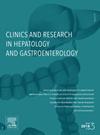一系列镰状细胞病相关的炎症性肠病:结肠累及和原发性硬化性胆管炎的高患病率
IF 2.4
4区 医学
Q2 GASTROENTEROLOGY & HEPATOLOGY
Clinics and research in hepatology and gastroenterology
Pub Date : 2025-05-23
DOI:10.1016/j.clinre.2025.102615
引用次数: 0
摘要
目的:镰状细胞病(SCD)与炎症性肠病(IBD)共发鲜有报道。我们的目的是探索SCD和IBD之间的交集,重点关注SCD对IBD自然病程和药物安全性的影响。方法:我们进行了一项多中心回顾性病例对照研究,包括连续诊断为IBD和SCD的患者。每名伴有SCD的IBD患者与多达4名无SCD的IBD患者配对。匹配标准为IBD类型、性别、出生日期、随访时间和诊断年份。主要结果是一个复杂的IBD病程。结果:共纳入IBD患者125例,其中SCD 24例。24例SCD患者中有23例有结肠受累。33.3%的患者伴有原发性硬化性胆管炎(PSC),而对照组的这一比例为1%。结论:SCD和IBD患者表现出独特的表型,持续累及结肠,PSC患病率高。本文章由计算机程序翻译,如有差异,请以英文原文为准。
A series of Sickle cell disease-associated inflammatory bowel diseases: high prevalence of colonic involvement and primary sclerosing cholangitis
Objective
Co-occurrence of Sickle Cell Disease (SCD) and Inflammatory Bowel Diseases (IBD) has been scarcely reported. Our aim was to explore the intersection between SCD and IBD, focusing on the impact of SCD on the natural course of IBD and drug safety.
Methods
We conducted a multicenter retrospective case-control study including consecutive patients diagnosed with IBD and SCD. Each IBD patient with SCD was matched with up to 4 IBD patients without SCD. Matching criteria were IBD type, sex, date of birth, length of follow-up and year of diagnosis. The primary outcome was a complicated IBD course.
Results
125 IBD patients were studied, including 24 SCD. 23/24 SCD patients had colonic involvement. 33.3 % had concomitant primary sclerosing cholangitis (PSC) compared to 1 % of controls (p < 0.001). Survival without a complicated IBD course was estimated at 58.7 % (CI95[49.6–69.5]) at 5 years for non-SCD patients, as compared to 63.3 % (CI95[45.7–87.6]) for SCD patients SCD (p = 0.36). The survival without the need of advanced therapy was estimated at 66.1 % (CI95[57.3–76.2]) at 5 years for non-SCD patient, and at 78.2 % (CI95[63–97.2]) in SCD patients (p = 0.45) Regarding treatment safety, 26.3 % of patients with SCD and 13.5 % of controls experienced adverse events with biologics (p = 0.17). There was one reported vaso-occlusive crisis associated with thiopurines.
Conclusion
Patients with SCD and IBD displayed a distinctive phenotype with constant colonic involvement and high prevalence of PSC.
求助全文
通过发布文献求助,成功后即可免费获取论文全文。
去求助
来源期刊

Clinics and research in hepatology and gastroenterology
GASTROENTEROLOGY & HEPATOLOGY-
CiteScore
4.30
自引率
3.70%
发文量
198
审稿时长
42 days
期刊介绍:
Clinics and Research in Hepatology and Gastroenterology publishes high-quality original research papers in the field of hepatology and gastroenterology. The editors put the accent on rapid communication of new research and clinical developments and so called "hot topic" issues. Following a clear Editorial line, besides original articles and case reports, each issue features editorials, commentaries and reviews. The journal encourages research and discussion between all those involved in the specialty on an international level. All articles are peer reviewed by international experts, the articles in press are online and indexed in the international databases (Current Contents, Pubmed, Scopus, Science Direct).
Clinics and Research in Hepatology and Gastroenterology is a subscription journal (with optional open access), which allows you to publish your research without any cost to you (unless you proactively chose the open access option). Your article will be available to all researchers around the globe whose institution has a subscription to the journal.
 求助内容:
求助内容: 应助结果提醒方式:
应助结果提醒方式:


